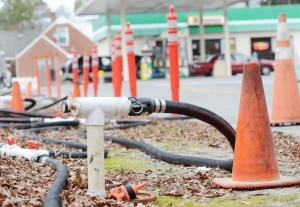State specialists testing old city petroleum spill site
By Matt Caulder
Published in News on February 7, 2014 1:46 PM

News-Argus/CASEY MOZINGO
Hoses run from a mobile extraction unit used to pull water out of the ground before testing the site of an old gasoline spill on Jefferson Avenue. The spill happened in 1994. State environmental specialists are required to monitor the location for years following such a spill to prevent groundwater contamination.
Environmental specialists are in Goldsboro this week to do a routine check on a 1994 petroleum spill.
Work began mid-week to suck up groundwater along Jefferson Avenue at Ash Street, the site of a nearly 20-year-old leak from Kangaroo Express tanks in that area. Soil testing will follow next month as part of an ongoing effort to monitor the site.
Since the November 1994 incident, the state Department of Environmental and Natural Resources has been monitoring the cleanup, which includes groundwater filtering and regular testing.
Rose Ballance, a hydrogeologist with DENR, said the testing is aimed at making sure that no contaminated soil reaches potable wells.
To pull the water out, a "mobile multi-phase extraction unit" was placed on Jefferson Avenue in front of the former Sunrise Learning Center. The hoses were attached to 2-inch-wide testing wells used to access the groundwater.
"We pull the contaminated water out, wait about a month and go out and test the soil," Ms. Ballance said. "It's an old incident that goes back many years that's just giving us some trouble."
Ms. Ballance said that she does not know how long the spill will take to clean up but that it has been "very difficult."
By pulling out the contaminated water and allowing the area to stabilize, the condition of the soil can be measured, Ms. Ballance said.
As it stands, all of the buildings in the area are serviced by city water, but DENR workers are looking further south on Jefferson Avenue to ensure there are no wells farther down the street that might be affected, Ms. Ballance said.
The site is still listed as high risk due to one irrigation well within 250 feet of the station, Ms. Ballance said. However, that well is not currently being used.
Because the irrigation well is still operational, the contamination standards are more stringent, keeping the spill on DENR's radar.
For a high risk site, the allowable benzene concentration is two parts per billion, but a test done in December 2011 showed the level at 1,000 parts per billion.
If the irrigation well were closed, the site would be dropped to a lower risk level and the site would essentially be cleared, Ms. Ballance said.
